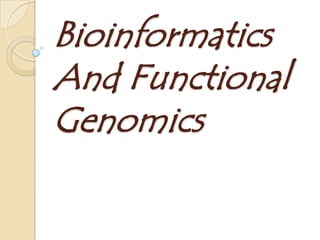
Bioinformatics and functional genomics
- 2. Outline… Bioinformatics Functional Genomics Sequence-based tools Microarray-based tools Gene Ontology System Biology approach to Bioinformatics and Functional Genomics
- 3. What is Bioinformatics? Bioinformatics is conceptualizing biology in terms of molecules (in the sense of physical-chemistry) and then applying "informatics" techniques (derived from disciplines such as applied mathematics, CS, and statistics) to understand and organize the information associated with these molecules, on a large-scale.
- 4. The development of new algorithms and statistics with which to assess relationships among members of large data sets. The analysis and interpretation of various types of data including nucleotide and amino acid sequences, protein domains and protein structures. The development and implementation of tools that enable efficient access and management of different types of information. Bioinformatics
- 5. Functional Genomics A field of molecular biology that attempts to make use of the vast wealth of data produced by genomic projects (such as genome sequencing projects) to describe gene (and protein) functions and interactions
- 6. Bioinformatics and Functional Genomics Focus on gene function ◦ At genome level, using ◦ High throughput methods Conducted using ◦ Sequence-based tools ◦ Microarray-based tools
- 7. Bioinformatics and Functional Genomics Because of the large quantity of data produced by these techniques and the desire to find biologically meaningful patterns, bioinformatics is crucial for analysis of functional genomics data.
- 8. Sequence-based tools • DAVID -The Database annotation, visualization and integrated discovery. • DG -DigiNorthern
- 10. DigiNorthern DigiNorthern (DN) is a web-based tool for virtually displaying expression profiles of query genes based on EST sequences. In addition, digital expression data is available for each UniGene through a pre-computed data set based on SAGE and/or ESTs.
- 12. Microarray based tools Gene Set Enrichment Analysis (GSEA) GSEA considers experiments with genome wide expression profiles from samples belonging to two classes, labeled 1 or 2. Genes are ranked based on the correlation between their expression and the class distinction. GEO Gene Expression Omnibus
- 14. Gene Ontology The Gene Ontology, or GO, is a major bioinformatics initiative to unify the representation of gene and gene product attributes across all species. More specifically, the project aims to: Maintain and develop its controlled vocabulary of gene and gene product attributes; Annotate genes and gene products, and assimilate and disseminate annotation data;
- 15. Gene Ontology Gene Ontology based enrichment analysis are provided by DAVID and Gene Set Enrichment Analysis (GSEA).
- 17. "A system biology" approach to bioinformatics and functional genomics in complex human diseases: arthritis. Human and other annotated genome sequences have facilitated generation of vast amounts of correlative data, from human/animal genetics, normal and disease-affected tissues from complex diseases such as arthritis using gene/protein chips and SNP analysis. These data sets include genes/proteins whose functions are partially known at the cellular level or may be completely unknown (e.g. ESTs).
Hinweis der Redaktion
- An expressed sequence tag or EST is a short sub-sequence of a cDNA sequence.[1] They may be used to identify gene transcripts, and are instrumental in gene discovery and gene sequence determination
